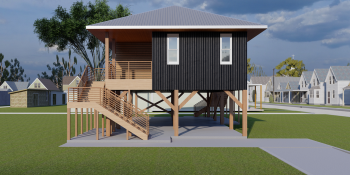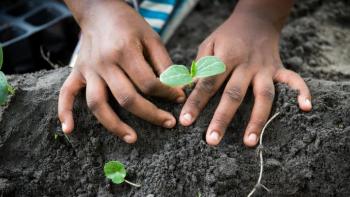In Arizona, Tucson Habitat for Humanity has developed the CHUCK Center – an innovative, state-of-the-art facility that serves as a construction hub, warehouse and training center where they are able to build prefabricated modular wall panels. This approach improves efficiency in wood framing and significantly reduces construction time, which helps accelerate housing solutions while also making it easier for volunteers to build and providing job training to inspire careers in the trades.
The affiliate aims to serve as a sustainability hub by venturing into building and selling accessory dwelling units, or ADUs, catering to senior populations and generating revenue to broaden their impact. With the CHUCK Center, Habitat Tucson’s annual home production will surge from 12 to over 30 by 2025.
In Louisiana, New Orleans Area Habitat for Humanity is leading efforts to integrate FORTIFIED roofing into all feasible constructions and create elevated FORTIFIED designs which secure the homes amidst worsening climate events.
Notably, many of these advances are developed in storm and hurricane-damaged areas, which help facilitate the safe return of families to their ancestral homes and ensure safety, energy efficiency and reduced costs for partner families. The initiative has already benefitted two individuals residing in FORTIFIED homes in Jean Lafitte, and a third will soon move into a similar home.
In North Carolina, Habitat for Humanity of the Sanford Area launched the lean lumber initiative, which aims to use leftover lumber from build projects in ways that benefit the local community. Upcycling events were held, creating participation, excitement and ideas within the community. Through this initiative, 12 families received birdhouses, one family received a doghouse, and 12 families will receive a future project using current lumber.
The greatest impact for the community is an opportunity for partnership and collaboration, such as working with agricultural departments to use the lumber in a community garden or with educational institutions to utilize scraps for teaching crafts or building techniques on a smaller scale. This initiative could create momentum on multiple levels, allowing for long-term success as well as protecting the environment.
In Michigan, Genesee County Habitat for Humanity has implemented advanced framing techniques, such as 24-inch on-center spacing, single top plates, ladder blocking, and insulated headers. These techniques reduce lumber use, lower carbon footprints and enhance energy efficiency, making housing more affordable and stable by cutting material costs. In addition, recycling excess wood further reduces expenses.
This approach improves Genessee County’s efficiency, resilience, and financial sustainability by decreasing labor and material costs, speeding up construction and enabling Genessee County Habitat for Humanity to assist more families.
In Kansas, Habitat for Humanity of the Northern Flint Hills is working to improve access to durable, energy-efficient homes in their area – particularly for rural and low-income communities. As part of a neighborhood revitalization strategy, removing unsafe structures and adding community assets benefits neighbors, and the use of wood products in panelized and stick-built homes ensures their performance, resilience and sustainability.
In addition, an effort to involve students in construction allows them to learn real-world construction and design skills, helping to foster the next generation of trades workers. Most importantly, this project instills hope in the community, demonstrating that high-performance housing is achievable for rural and low-income communities.
In Minnesota, Central Minnesota Habitat for Humanity prioritizes supporting low-income BIPOC households, especially Foundation African Americans. They have focused their efforts on three key impacts: equipping students with job market skills, addressing racial homeownership gaps in St. Cloud and Minnesota, and fostering community healing from historical injustices.
Insights gained include the diversity of St. Cloud Tech and the ongoing journey to involve more BIPOC students. Central Minnesota Habitat acknowledges that closing the racial homeownership gap requires persistent effort and partnerships. Their initiatives have resulted in home construction, student empowerment, new collaborations and upcoming home sales to deserving BIPOC families.







